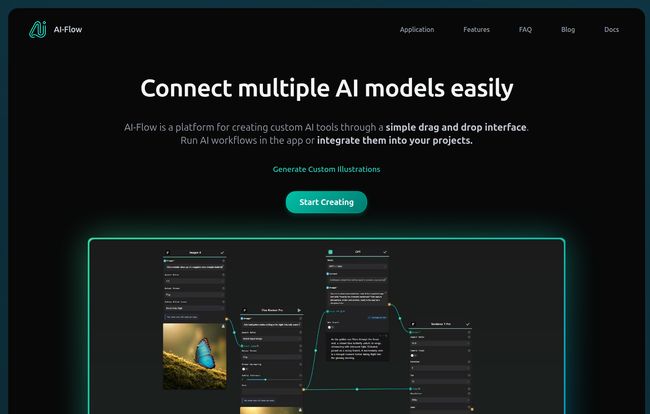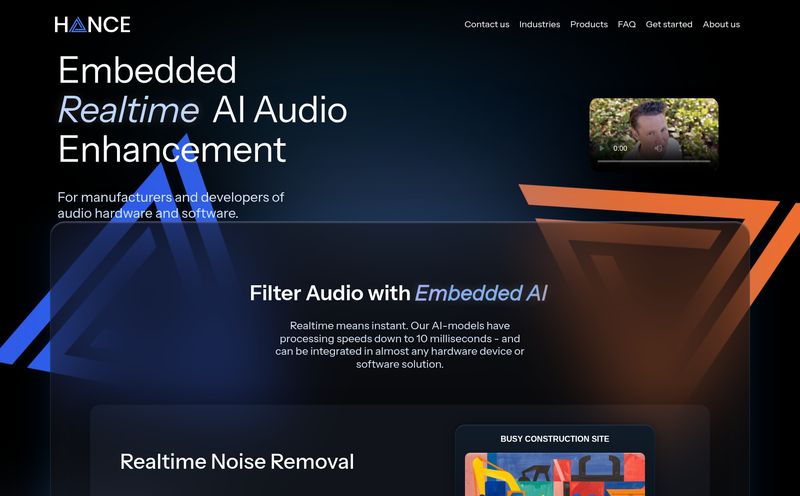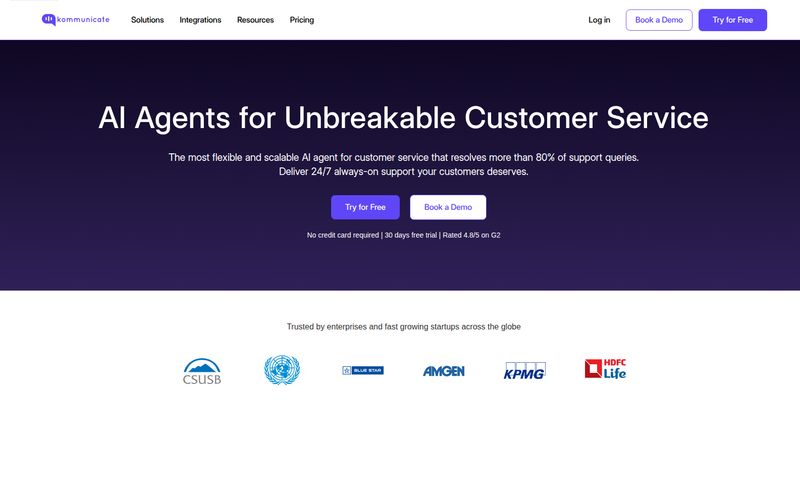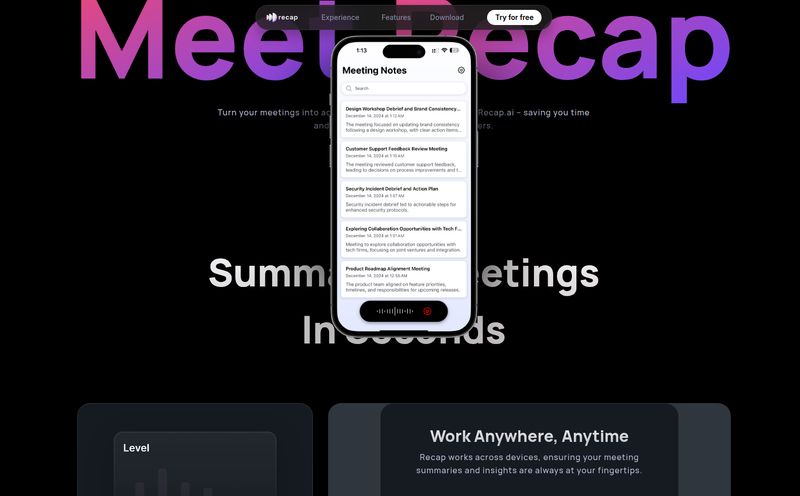The AI space is moving at a speed that makes my morning coffee feel inadequate. Every week there's a new model, a new platform, a new 'game-changer' that promises to revolutionize how we do… well, everything. It’s exciting, sure, but it's also a little exhausting. It feels like you have to pledge allegiance to one ecosystem—you're either an OpenAI person, an Anthropic enthusiast, or a StabilityAI stan. What if you want to play with all the toys?
I’ve been in the SEO and traffic game for years, and I’m always looking for an edge, a way to automate the grunt work so I can focus on strategy. I've been chaining API calls with Python scripts for a while, and while it's powerful, it's also… clunky. One little syntax error and the whole Rube Goldberg machine falls apart. So when I stumbled upon AI-Flow, my curiosity was definitely piqued. An open-source platform that lets you visually connect different AI models? It sounded a bit like Zapier, but specifically for AI. A universal remote for the AI universe. I had to see if it lived up to the hype.
So, What Exactly Is AI-Flow?
Think of AI-Flow as a set of digital Lego blocks. Each block is a powerful AI model—like GPT-4 for text, DALL-E 3 for images, or a model from Anthropic for nuanced conversation. On their own, they're cool. But AI-Flow gives you the board to connect them all, letting you build something new and custom without needing to be a hardcore developer.
It's an open-source platform with a drag-and-drop interface. The whole point is to let you create your own unique AI workflows. For instance, you could build a process that takes a blog post title, asks an AI to write an outline, sends that outline to another AI to flesh out the content, and then hands it off to a third AI to generate a header image. All in one smooth, automated flow. That’s the dream, right?
The Drag-and-Drop Magic: First Impressions
Getting started, the first thing that hits you is the clean interface. It doesn't bombard you with a million options. It presents a blank canvas, and on the side, you have your palette of AI models and tools. You literally drag a model onto the canvas, fill in a few details (like your API key and the prompt you want to use), and then connect it to the next step.
There's a certain satisfaction, a real creative spark, that comes from visually mapping out a process. It feels less like coding and more like drawing a flowchart. You can see the logic, the path your data is taking from input to output. This visual approach just clicks with how my brain works. For anyone who has ever felt intimidated by a blinking cursor in a code editor, this is a breath of fresh air.

Visit AI-Flow
Connecting All The Big AI Brains
This, for me, is the platform's killer feature. We're living in an era of specialized AI. Some models are incredible poets, others are master artists, and some are just really, really good at summarizing dense text. Being locked into one provider is like hiring a master plumber to do your electrical work. It just doesn't make sense.
A True Multi-Model Playground
AI-Flow lets you bring them all into one sandbox. The website mentions over 15 models, including the heavy hitters from OpenAI, StabilityAI, Anthropic, and Replicate. This means you can create a workflow that uses the best tool for each part of the job. Need a photorealistic image? Grab a node for Stable Diffusion. Need to write some killer marketing copy? Pull in a node for one of OpenAI's or Anthropic's models. This flexibility is something I've been waiting for, and it moves us away from AI tribalism and towards a more results-oriented approach.
Handy Templates to Get You Started
Staring at a blank canvas can be daunting. AI-Flow knows this, so they've included a bunch of ready-to-use templates. I saw things like 'Summarize Youtube Video,' 'GPT Image Generation,' and 'Professional Headshot.' These are fantastic starting points. You can load a template, see how it's built, and then start tinkering with it to fit your specific needs. It’s a great way to learn the ropes without having to build your first creation from scratch. It dramatically lowers the barrier to entry for non-technical users.
From Workflow to API: The Automation Power-Up
Okay, this is where it gets really interesting for the business and marketing folks. Creating a cool workflow is one thing. But AI-Flow lets you take that entire workflow and instantly turn it into an API endpoint. What does that mean in plain English? It means you can integrate your custom AI creation into other applications.
Imagine you build that blog-writing workflow I mentioned earlier. By turning it into an API, you could build a simple form on your company's internal website where a content marketer just types in a title, clicks a button, and gets a full draft and image back a minute later. You're not just using AI; you're building custom, automated tools for your team. The possibilities here are pretty much endless, from lead enrichment tools to automated social media content creators.
The Good, The Bad, and The Techy
No tool is perfect, of course. After playing around with AI-Flow, here’s my honest breakdown of what I loved and what you should be aware of.
What I Really Liked
The open-source nature is a huge win. It means a community can build on it, and you're not at the mercy of a single company's pricing whims. The user interface is genuinely intuitive, making complex processes feel manageable. And the multi-model support, as I've said, is the star of the show. It’s empowering. It feels like you’re finally in the driver’s seat of your AI strategy, not just a passenger.
A Few Things to Keep in Mind
Now for a dose of reality. While it's user-friendly, the initial setup isn't exactly a one-click affair, espescially if you want to run it locally. You'll need a little bit of technical comfort to get it up and running. Nothing a good tutorial can't solve, but it’s not quite at the consumer-app level of simplicity yet. Also, if you run it locally, you still need an internet connection for the tool to talk to the various AI model APIs. This isn't a completely offline solution. And if you go the cloud route, remember that you'll likely incur costs for the server resources you use, which is standard practice.
So, What's the Price Tag?
This is the million-dollar question, isn't it? Here's the deal: AI-Flow itself is open-source, which generally means the software is free to use. When I went to find a pricing page on their site, it actually led to a 404 error—a little hiccup that shows this is still a growing project. But the model is clear: your costs aren't for AI-Flow, they're for the AI you use through it. You'll need your own API keys from providers like OpenAI, and you'll pay them directly based on your usage. If you deploy it on a cloud service, you’ll pay for that hosting. I actually prefer this model. It's transparent. You only pay for what you consume, with no platform subscription fee on top (at least for now).
Frequently Asked Questions about AI-Flow
1. Can I really use AI-Flow for free?
Yes, the AI-Flow software itself is open-source and free to download and use. However, you will have to pay for the usage of the AI models you connect to it via their APIs (e.g., your OpenAI or StabilityAI bill) and any cloud hosting costs if you choose not to run it on your local machine.
2. What kind of AI models can I connect?
AI-Flow supports a growing list of models from major providers. This includes large language models (LLMs) for text generation, image generation models, and other specialized AIs from companies like OpenAI, Anthropic, StabilityAI, and Replicate.
3. Do I need to be a developer to use AI-Flow?
Not to build workflows. The drag-and-drop interface is designed for everyone. However, some technical knowledge is helpful for the initial setup, especially for local deployment, and for integrating the APIs you create into other projects.
4. How does AI-Flow generate images or text?
AI-Flow doesn't generate content itself. It acts as a control center or an orchestrator. You tell it which external AI model to use (like DALL-E 3 for images), and AI-Flow sends your request to that model's API and then displays the result or passes it to the next step in your workflow.
5. Can I run AI-Flow completely offline?
No. While you can host the AI-Flow application on your own local computer, it still needs an active internet connection to communicate with the cloud-based AI models from providers like OpenAI. The workflow processing happens locally, but the 'thinking' is done by the external APIs.
Is AI-Flow Worth Your Time? My Final Verdict
After spending some quality time with it, I'm genuinely impressed. AI-Flow isn't just another tool; it's a new way of thinking about how we build with AI. It's for the tinkerers, the agencies, the startups, and the marketers who see the potential of AI but don't want to be handcuffed to a single system.
It successfully bridges the gap between complex coding and practical application. If you’re looking to create powerful, custom AI-driven automations and you love the idea of mixing and matching the best models on the market, then yes, AI-Flow is absolutely worth your time. It’s a peek into a future where we’re not just users of AI, but creators of our own intelligent tools. And that's a future I'm excited about.



